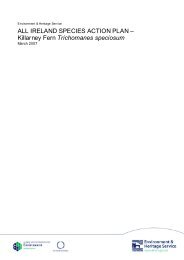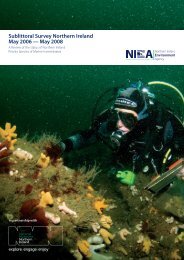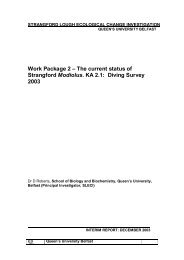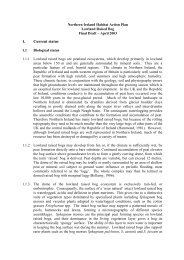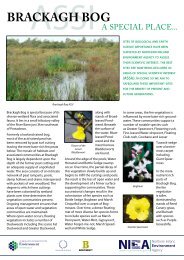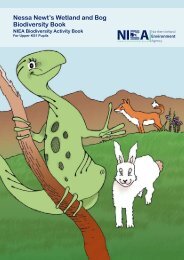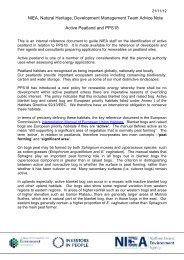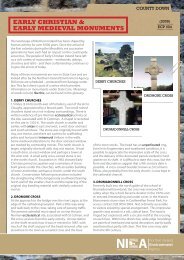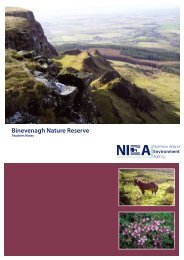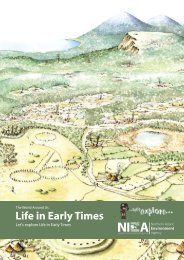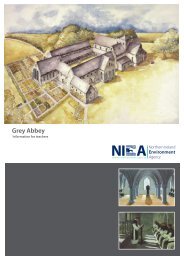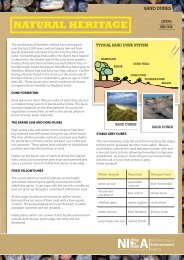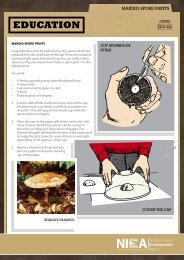Fergus Fox
Fergus Fox
Fergus Fox
Create successful ePaper yourself
Turn your PDF publications into a flip-book with our unique Google optimized e-Paper software.
<strong>Fergus</strong>’ Nature Diary<br />
Crawfordsburn Country Park<br />
Activity Book
This book belongs to<br />
I got this book from<br />
On<br />
<strong>Fergus</strong> the <strong>Fox</strong> lives in the Park<br />
Text: Elizabeth Newbery<br />
Design: Sarah Beatty<br />
© Copyright Northern Ireland Environment Agency
Where am I?<br />
Pretend you are a bird flying high in the sky. Look below!<br />
This is what you see.<br />
Can you see the sea?<br />
Colour it blue when you get home.<br />
Now pretend that you are even higher up. You are sitting on a<br />
cloud! This is what you see below you.<br />
Put a red spot on the map<br />
where you live.<br />
1
January<br />
2<br />
Keeping Warm in Winter<br />
January is usually the coldest month of the year<br />
This animal grows thicker wool in<br />
winter.<br />
What is it?<br />
This animal grows layers of fat in<br />
winter.<br />
What is it?<br />
Birds fluff up their feathers in winter.<br />
This bird is a robin.<br />
Colour in his red breast.<br />
This animal goes to sleep in winter.<br />
What is it?<br />
How do you keep warm in winter?
January<br />
Shivering Timbers<br />
Trees need sunshine and water to make food. In winter there<br />
is not much sunshine, and water is often frozen. So trees go to<br />
sleep in winter, like hedgehogs!<br />
The leaves of some trees fall off<br />
in autumn. They are called<br />
deciduous trees.<br />
Do you know the name of any<br />
deciduous trees?<br />
Other trees keep their leaves in<br />
winter. They are called<br />
evergreens. Can you think why?<br />
Evergreens have tough, shiny leaves or<br />
very thin leaves. Scots Pines are evergreen.<br />
They look like this.<br />
There are lots of Scots Pines<br />
growing in Crawfordsburn.<br />
How many can you spot?<br />
What type of leaves do<br />
Scots Pines have?<br />
Pick one up and stick<br />
it here.<br />
3
February<br />
4<br />
Bursting Buds<br />
The countryside looks very bare in winter. But there are lots of<br />
flowers and buds if you know where to look.<br />
Tick off these plants as you find them<br />
pussy willow hazel catkins crocus<br />
winter<br />
heliotrope<br />
a young shoot under dead leaves<br />
horse chestnut bud<br />
beech tree bud<br />
snowdrop
February<br />
Hedgehogs to Eat<br />
You will need some chocolate buns, buttercream icing,<br />
chocolate strands, chocolate mint sticks, silver balls, glace<br />
cherries.<br />
Make some buttercream icing like this:<br />
1. Mix 2 tablespoons of<br />
cocoa powder with 1<br />
1/2 tablespoons of very<br />
hot water together.<br />
Make your hedgehogs like<br />
this:<br />
Turn the buns upside down. Spread<br />
some icing on them. Sprinkle the<br />
chocolate strands on them. Push<br />
in the mint sticks for prickles. Add<br />
2 silver ball eyes and a glace cherry<br />
nose.<br />
2. Beat 125g (4oz) soft<br />
margarine until it is<br />
creamy. Add the cocoa<br />
mixture.<br />
3. Now add 250g (8oz)<br />
icing sugar. Mix it<br />
altogether.<br />
5
March<br />
6<br />
Birds and Nests<br />
Birds make nests ready for their eggs in spring.<br />
The nest keeps the eggs<br />
safe from enemies.<br />
The baby birds grow inside<br />
the eggs.<br />
The bird sits on the eggs to<br />
keep them warm.<br />
When they are big enough<br />
they hatch out.<br />
Oystercatchers lay their eggs on the ground. The eggs match<br />
the colour of the ground.<br />
Can you find the<br />
oystercatcher’s eggs<br />
hidden in this<br />
picture?
March<br />
Building Nests<br />
Nests are usually made of twigs, grass and feathers. But some<br />
birds use other things such as mud.<br />
Build a nest of your own!<br />
You will need a small ball of clay (or plasticine) and some<br />
materials such as feathers, straw, wool, moss and leaves.<br />
Build a nest like this:<br />
Press thumb in a ball of clay<br />
(or plasticine). Pinch the clay<br />
between fingers.<br />
Can your nest hold two hens’ eggs?<br />
Is it as good as a real bird’s nest?<br />
Which bird would live in your nest?<br />
Birds build nests in all sorts of places such as in hedges, in holes in trees, under<br />
the roofs of houses or even on the edge of cliffs.<br />
Look for trees with nests in the Park.<br />
How many nests can you spot?<br />
Line the nest with some of the materials you<br />
have collected to make it warm and cosy.<br />
7
April<br />
8<br />
Plenty of Plants<br />
Look at the picture of the Park on Page 1.<br />
Can you spot the woodland?<br />
Can you spot the seashore?<br />
Plants that grow in the woodland are different from the plants<br />
that grow near the seashore.<br />
Woodland Plants<br />
Look for these plants in the woods. They flower before the trees<br />
have leaves on them.<br />
celandine<br />
Colour them in when you get home.<br />
wood sorrel<br />
ramsons
April<br />
Sea Shore Plants<br />
Seashore plants must find fresh water otherwise they will die.<br />
They must stand up to strong winds from the sea too.<br />
Thrift has long roots to<br />
search out water.<br />
Stone crop grows<br />
low so the wind blows<br />
over it.<br />
Scurvy grass stores<br />
water in fat leaves.<br />
Eggs for Easter<br />
The whinbush has bright yellow flowers. They can be used to<br />
make a bright yellow dye. Dye some eggs for Easter like this.<br />
whinbush<br />
Find a place where<br />
there are lots of<br />
whinbushes. Collect<br />
the yellow flowers.<br />
Put them in a<br />
saucepan of boiling<br />
water with the eggs.<br />
Watch your eggs turn<br />
bright yellow!<br />
9
May<br />
Make Friends with a Tree!<br />
Choose the tree you like best.<br />
Why do you like it best? Is it the shape? Or the colour?<br />
Does it look like a friendly tree? Or a scarey tree?<br />
Shut your eyes and feel<br />
the bark. Tick which word<br />
tells you about it best.<br />
nobbly<br />
smooth<br />
rough<br />
flakey<br />
slippery<br />
Is there anything extra<br />
growing on your tree?<br />
What do the leaves look<br />
like? Draw one here.<br />
10<br />
Don’t forget to draw the roots! The roots hold the tree<br />
firmly in the ground. They stop it from blowing over.<br />
Roots take water and other things out of the ground, so<br />
that the tree can grow.
Who lives in an Oak Tree?<br />
A large oak tree is home to lots of birds, animals and insects.<br />
There are 8 hiding in this picture.<br />
How many can you find?<br />
I can find<br />
May<br />
11
June<br />
Dip into a Pond<br />
You will need: a net and an ice cream tub half filled with<br />
pond water. If you do not have a net use a kitchen sieve.<br />
A small hand lens is useful for looking at very small things.<br />
12<br />
Dip your net into the pond. Turn it<br />
upside down into your tub of water.<br />
Shake the net gently in the water.<br />
Have you caught any of these?<br />
a water snail<br />
a great diving beetle<br />
a whirligig beetle<br />
a water boatman<br />
a newt<br />
a pond skater
June<br />
A Walk to the Waterfall<br />
Find the waterfall in the picture of the Park on page 1. Why not<br />
go to see it? You will hear it before you see it.<br />
For you to colour.<br />
Can you make a sound like the waterfall?<br />
13
July<br />
Creepy Crawlies<br />
Insects and small animals are found in all sorts of places. Did you<br />
know there are more insects than any other kind of animal?<br />
Look for insects and small animals<br />
in trees like this.<br />
Put a piece of paper under a tree.<br />
Tap a branch with a stout stick<br />
to knock off the insects.<br />
Have you found any of these?<br />
If you look under the dead leaves you might find these<br />
114<br />
small spider<br />
woodlouse<br />
spider<br />
greenfly caterpillar<br />
ant<br />
centipede<br />
fly earwig<br />
slug
July<br />
Keeping Caterpillars<br />
A baby butterfly or moth is called a caterpillar. It changes into a<br />
butterfly or moth like this:<br />
eggs caterpillar pupae butterfly<br />
A Caterpillar House<br />
Keep a caterpillar. Watch it change into<br />
a butterfly or moth.<br />
You will need:<br />
a large plastic sweet jar<br />
some old tights<br />
a rubber band<br />
an empty yogurt pot to hold water<br />
for the plant which the caterpillar eats<br />
a piece of bark or rough wood<br />
some damp soil<br />
Look for a caterpillar. Take a piece of<br />
the plant it was eating. Keep your<br />
caterpillar in a cool place. Check it<br />
every day. When it changes into a<br />
moth or a butterfly, let it go.<br />
Watch it fly away!<br />
15
August<br />
A Game for the Seaside<br />
Play this game with your family or friends. The first person to<br />
find all of these things is the winner.<br />
a piece of seaweed a dead crab a feather a piece of glass<br />
smoothed by<br />
the sea<br />
a whelk a piece of wood a smooth<br />
pebble<br />
Exploring Rockpools<br />
Look for the rock pools behind the rocks at Helen’s Bay. They are<br />
great fun to explore. Keep very still. Wait for the animals to come<br />
out of hiding.<br />
Can you spot any of these?<br />
16<br />
limpet<br />
crab<br />
starfish<br />
sea anemone<br />
periwinkle<br />
a razor shell<br />
sea lettuce
August<br />
Sea Shells<br />
Shells are the homes of animals with soft bodies. They live in<br />
shells to protect their bodies.<br />
Shells come in all shapes and sizes. Can you find a very, very tiny<br />
shell? And a very large shell? Draw round them with a pencil in<br />
the boxes.<br />
This is my<br />
smallest shell.<br />
This is my<br />
largest shell.<br />
Catch a Crab<br />
Crabs love bacon rinds!<br />
Catch a crab like this.<br />
You will need a bucket filled with sea water, string and some bacon rinds.<br />
Tie the string to the bacon rind. Dangle it in a rock pool. Watch the crabs grab<br />
the bacon! Lift them out carefully while they hang on. Put them in the bucket.<br />
Tip them gently back in the water before you go home.<br />
17
September<br />
Birds on the Beach<br />
Spot these birds on the beach. Then follow the lines to find out<br />
what they eat.<br />
turnstones<br />
Spotting Seals<br />
Grey Seals like rocky shores, so you might be lucky and spot one<br />
at Helen’s Bay.<br />
Grey Seals come ashore<br />
to have their babies in<br />
the autumn.<br />
Do you know what<br />
baby seals are called?<br />
18<br />
fish<br />
herring gull<br />
worms and<br />
sand shrimps<br />
oystercatchers<br />
small animals which<br />
hide under stones<br />
and seaweed<br />
cockles and mussels<br />
redshank<br />
fish and dead things<br />
washed up by the sea<br />
cormorant
September<br />
Feeling Feathers<br />
Birds lose some of their feathers in late summer, so it is a good<br />
time to collect them. Sort them out into different sizes. Stick<br />
them in here.<br />
Shut your eyes and stroke a<br />
feather. What does it feel like?<br />
Tick the word you think is best.<br />
soft<br />
spikey<br />
stiff<br />
smooth<br />
silky<br />
Eider Ducks<br />
Eider ducks do not live in many places around Britain, but they<br />
do live at Crawfordsburn.<br />
Eider ducks have especially soft<br />
feathers on their breasts. They line<br />
their nests with these feathers to<br />
keep the eggs warm.<br />
Some people have bed covers<br />
filled with eider feathers. Do you<br />
have one on your bed?<br />
Can you make up a word of<br />
your own to say what your<br />
feathers feel like?<br />
This is the biggest feather.<br />
This is the smallest feather.<br />
19
October<br />
Scattering Seeds<br />
It is often very windy in autumn. The winds help to scatter<br />
seeds. Most seeds are blown away by the wind.<br />
Burrs have tiny hooks<br />
which hook on to animal<br />
hair. When the animal rubs<br />
against a fence the burrs<br />
drop off and grow.<br />
Fruit seeds are carried by birds.<br />
They eat the berries with the<br />
seeds inside them. The seeds pass<br />
through their droppings and grow.<br />
Dandelions have seeds attached<br />
to tiny ‘parachutes’. The wind<br />
carries them away.<br />
Ash and sycamore seeds<br />
have ‘wings’ to catch the<br />
wind.<br />
Sorting Seeds<br />
Seeds come in all sorts of shapes, colours and sizes. How many<br />
can you find in the Park?<br />
Sort them out when you get home.<br />
Stick them into the right box.<br />
20<br />
flat seeds round seeds different coloured seeds
October<br />
A Seed Necklace<br />
Make a necklace with seed like this.<br />
You will need different sized seeds, (large seeds are easier to use), a darning<br />
needle, thick thread.<br />
Tie a big knot in one end<br />
of the thread.<br />
When you have finished, tie<br />
another knot in the other end.<br />
Tie the two ends together.<br />
Conkers<br />
Conkers are the seeds of the horse chestnut tree. Do you know<br />
how to play ‘conkers’?<br />
Choose the fattest, shiniest conkers you can find. Ask a grown<br />
up to pierce them with a corkscrew. Thread some string through<br />
and tie a knot at one end. You must try and smash the other<br />
person’s conker by hitting it with yours.<br />
A Conker Race<br />
Have you tried a conker race? Each<br />
person pushes a conker along the<br />
ground with their nose! The first one<br />
to the finishing line wins.<br />
Push the needle and thread<br />
through the seeds.<br />
21
November<br />
Feeding Birds<br />
Food becomes harder for birds to find in winter. You can help<br />
them by putting out food.<br />
Which food do birds like best? Put different types of food into<br />
small dishes. Try sunflower seeds, crumbs of bread and cheese,<br />
peanuts and cold boiled potatoes.<br />
Which do the birds like best?<br />
Which do the birds like least?<br />
Feeding Blue-tits<br />
Blue tits like peanuts. You can<br />
make a bird feeder for them<br />
from a plastic bottle like this:<br />
You will need:<br />
a plastic fizzy drink bottle<br />
string<br />
some peanuts (not salted)<br />
Ask a grown-up to cut some<br />
holes.<br />
22
November<br />
The Windmill at Crawfordsburn<br />
Look for the old stump of a windmill on your way out. You can see it from the<br />
Park drive, but you cannot walk up to it because it is on someone else’s land.<br />
A long time ago it used to grind barley and oats into flour.<br />
The Story of the Miller and the Wind Fairies<br />
Do you know what wind fairies are? A long time ago<br />
there was a miller who believed in wind fairies. Wind<br />
fairies were naughty. They travelled around Ireland<br />
looking for mischief. They were very fond of making<br />
trouble for millers!<br />
One day the wind fairies heard the sound of a clattering<br />
mill. They hid in the windmill and made a plan. First they made sure<br />
that there was a nice fresh wind. The miller was pleased. But he did not know<br />
the wind fairies were hiding in the mill. The miller got busy pouring in barley at<br />
one end and filling sacks of flour at the other end. Suddenly<br />
the wind fairies changed the way the wind blew.<br />
The miller quickly re-set the sails and he got busy again.<br />
But the wind fairies changed the way the wind blew<br />
again! The poor miller quickly went out and re-set<br />
the sails once again. The wind fairies were enjoying<br />
themselves. They made the wind blow so hard that the<br />
sails bent and the machinery whizzed round very fast.<br />
Then they made the wind go away so that the windmill<br />
would not work.<br />
Now the miller was used to the wind changing<br />
direction, first blowing strongly and then not at all - but<br />
not all at once. In a flash he realised that<br />
wind fairies were to blame! Now he<br />
had to think of a plan to get them out of the mill. So do<br />
you know what he did? He threw handfuls of flour into the<br />
wind. The wind fairies came out of hiding and spent the<br />
rest of the day chasing the flour around and leaving the<br />
miller to get on with his work!<br />
Do you believe in wind fairies? If you listen very carefully<br />
when the wind blows you might hear them. But be careful!<br />
They may be planning to make mischief for you!<br />
23
December<br />
Winter Walls<br />
In winter the plants have died down. So winter is a good time<br />
for looking at walls.<br />
Look out for the wall near the pond. It is home to lots of insects,<br />
small animals and plants.<br />
Tick the boxes as you spot these things.<br />
snail fungus spider fern slug<br />
Who am I?<br />
I like nice damp places. I<br />
have a hard shell and a soft<br />
body. I have no legs.<br />
Who am I?<br />
Join up the dots and find out.<br />
Then colour me in.<br />
24
December<br />
Planting Trees<br />
Trees are like people. They do not live for ever. When an old tree<br />
dies in the Park a new one is planted.<br />
Trees are planted in the winter when it is not too cold. Young trees are protected<br />
with a tree guard then, rabbits and other animals cannot eat them before they<br />
have a chance to grow.<br />
How many young trees can<br />
you spot in the Park?<br />
Grow Your Own Tree<br />
Look for a seed such as an acorn, a conker, sycamore wings or a<br />
seed from a beech tree.<br />
You will need a flowerpot, enough soil to fill<br />
the pot, a plastic bag<br />
and a rubber band.<br />
Soak the seed in warm<br />
water. Put some stones<br />
in the bottom of the<br />
flowerpot. Put most of<br />
the soil in the pot.<br />
Put in the seed and<br />
cover it with the rest of<br />
the soil.<br />
Put the plastic bag over<br />
the pot. Keep it in place<br />
with the rubber band.<br />
Tree Guard<br />
Leave on a sunny<br />
window sill to sprout.<br />
When the seedling<br />
comes up take the bag<br />
off and water it.<br />
25
For 2 or more players<br />
You will need 1 counter each and a dice. Throw 6 to start. The first one to reach the countryside<br />
centre on square 30 is the winner. To land on square 30 you must throw the exact number.<br />
Northern Ireland Environment Agency<br />
Klondyke Building<br />
Cromac Avenue<br />
Gasworks Business Park<br />
Belfast BT7 2JA<br />
T. 0845 302 0008<br />
www.ni-environment.gov.uk<br />
Printed on 100% post consumer waste<br />
Printed on 100% post consumer waste<br />
Our aim is to protect, conserve and promote the<br />
natural and built environment for the benefit of<br />
present and future generations.<br />
ISBN No. ......................<br />
Ref No: 04/04.24



